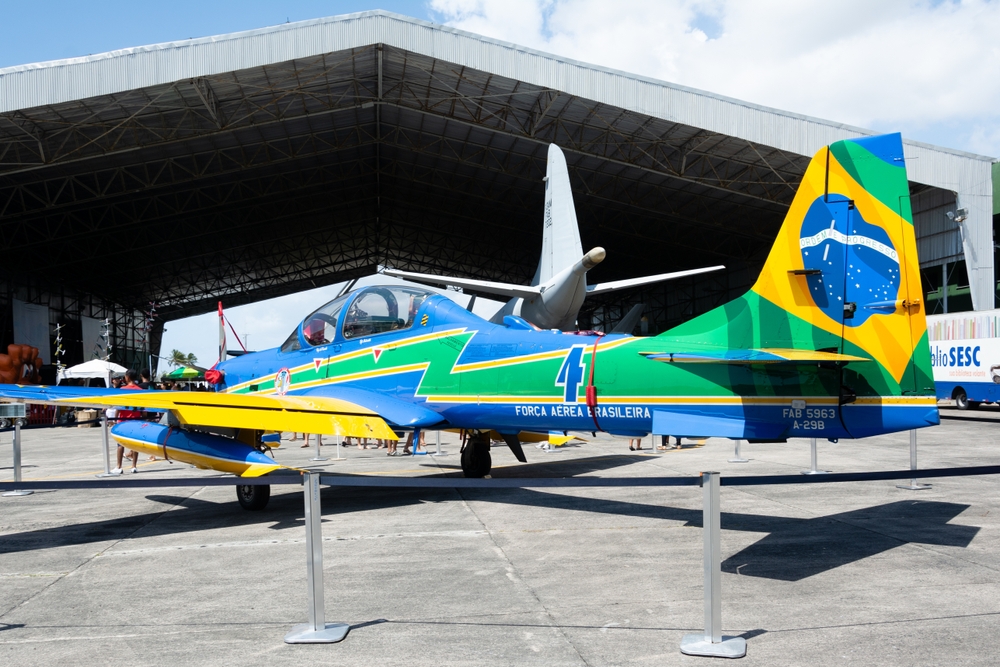Table of Content
ToggleIntroduction
Brazil’s quest for aerospace self-sufficiency has been a key part of its national strategy for decades. The country has made great strides in developing its own aviation industry, with a focus on both civilian and military applications. Brazil has achieved significant aerospace self-sufficiency through its national champion company Embraer and strategic government investments.
This push for self-reliance in aerospace has yielded impressive results. Brazil now produces a wide range of aircraft, from small private planes to commercial jets. The Brazilian Air Force has also benefited from domestically produced military aircraft and technology.
Brazil’s aerospace sector has become a source of national pride and a driver of economic growth. It has created high-skilled jobs and spurred innovation in related fields. The country’s success in this area serves as a model for other developing nations looking to build up their own high-tech industries.
Key Takeaways
- Brazil has built a thriving aerospace industry centered around Embraer
- The sector boosts national defense capabilities and economic development
- Government support and investment have been crucial to achieving self-sufficiency
Historical Overview of Brazil’s Aerospace Ambitions
Brazil’s aerospace journey began with early aviation pioneers and grew through military foundations. The country gradually built a robust aeronautical industry, aiming for self-sufficiency in aerospace technology.
Aviation Pioneers and Military Foundations
Brazil’s aviation history started with Alberto Santos-Dumont, a key figure in early flight. He made significant contributions to aviation, including the first powered flight in Europe in 1906.
The Brazilian military played a crucial role in advancing aerospace capabilities. They established the Air Force in 1941, which spurred demand for aircraft and related technologies.
In the 1940s and 1950s, Brazil focused on building its aerospace knowledge. The country created the Technological Institute of Aeronautics (ITA) to train engineers and develop aerospace expertise.
Development of Aeronautical Industry
Brazil’s aeronautical industry took off in the 1960s with the creation of Embraer. This state-owned company became a major aircraft manufacturer, producing both civilian and military planes.
Embraer’s success helped Brazil become more self-sufficient in aerospace technology. The company developed several successful aircraft models, including regional jets that gained international popularity.
Brazil also invested in space technology. The country launched its first satellite in 1993 and developed a space program aimed at achieving orbital launch capabilities.
These efforts reflect Brazil’s ambitious goals in aerospace. The country has worked to build a strong domestic industry while also competing in global markets.
The Role of Embraer in National Aerospace
Embraer has been key to Brazil’s aerospace success. The company has grown from a state-owned enterprise to a global leader in aircraft manufacturing.
Public to Private Transition
Embraer began as a state-owned company in 1969. It focused on building Brazil’s aviation industry. The government gave Embraer strong support. This helped the firm grow fast.
In 1994, Embraer became a private company. This change boosted its global reach. The firm kept close ties with Brazil’s government. But it gained more freedom to make business choices.
The shift let Embraer compete better worldwide. It could react faster to market needs. The company grew its product range. It moved into new areas like defense and business jets.
Global Impact and Contributions
Embraer has become a major player in global aviation. Its planes fly for airlines around the world. The company is known for regional jets and military aircraft.
Embraer’s success has boosted Brazil’s economy. It brings in foreign money through exports. The firm has created many high-skill jobs in Brazil.
The company works with global partners. This has brought new tech to Brazil. It has helped grow the country’s aerospace know-how.
Embraer trains Brazilian engineers and technicians. This builds local talent. It helps Brazil stay competitive in aerospace.
National Defense and Security Strategy
Brazil’s aerospace self-sufficiency efforts are closely tied to its defense and security goals. The country aims to boost its military capabilities while reducing reliance on foreign suppliers.
Air Defense Systems
Brazil has made significant progress in developing its own air defense systems. The Brazilian Air Force has focused on creating radar and missile technologies to protect its airspace. These systems include ground-based radars and surface-to-air missiles.
One key project is the ASTROS 2020 system. It can launch various types of missiles and rockets. This versatile platform enhances Brazil’s ability to defend against aerial threats.
The country is also working on integrating these systems with its existing aircraft. This creates a more robust air defense network. Brazil’s efforts aim to cover its vast territory and long coastline effectively.
Collaboration with Foreign Suppliers
While aiming for self-sufficiency, Brazil still works with foreign suppliers in some areas. This approach helps fill gaps in technology and expertise. The country often seeks technology transfer agreements with foreign partners.
Brazil has partnered with companies from countries like France, Sweden, and Israel. These collaborations focus on specific military materials and systems. For example, Brazil worked with Sweden’s Saab to develop the Gripen fighter jet.
The goal is to learn from these partnerships and eventually produce more components locally. This strategy helps Brazil build its defense industry while meeting immediate needs. It’s a balanced approach to achieving long-term self-sufficiency in aerospace and defense.
Brazil’s Investment in Aerospace Technology
Brazil has made significant strides in aerospace technology through focused investment and research efforts. The country aims to boost its self-sufficiency in this crucial sector.
Government and Private Sector Funding
The Brazilian government has been a key player in funding aerospace initiatives. It established the Aerospace Technical Centre (CTA), which became a hub for aeronautical research and development. This move showed Brazil’s commitment to advancing its aerospace capabilities.
Private sector involvement has also been crucial. Companies have invested in upgrading technology and training engineers. This partnership between public and private entities has helped Brazil make progress in aircraft manufacturing and related technologies.
The aviation industry has seen substantial financial support. Funds have been directed towards developing both military and civilian aircraft. This strategy aims to reduce dependence on foreign technology and boost domestic production.
Research and Development Focus
Brazil’s R&D efforts in aerospace have been diverse and strategic. The Instituto de Pesquisas Tecnológicas (IPT) has been at the forefront of Brazilian aeronautical research. It has played a key role in advancing aircraft technology.
Scientific development has been a priority. Brazilian researchers have worked on innovative materials, propulsion systems, and avionics. These efforts have led to technological advancements in aircraft design and performance.
The country has also invested in training skilled professionals. Universities and technical institutes offer specialized aerospace engineering programs. This focus on education ensures a steady supply of experts to drive the industry forward.
Collaboration with international partners has boosted Brazil’s aerospace capabilities. Joint research projects and technology transfers have helped accelerate progress in key areas.
Aerospace Industry as a Catalyst for Innovation
Brazil’s aerospace sector drives technological progress and creates skilled jobs. It pushes the country to the forefront of aviation and space technology.
Technological Leadership
The aerospace industry sparks innovation in Brazil. Companies invest heavily in research and development. This leads to new materials, better designs, and improved manufacturing processes.
Brazilian aerospace firms often partner with universities. These partnerships result in cutting-edge technologies. For example, they develop lightweight composites and advanced avionics.
The industry also boosts innovation in other sectors. Aerospace breakthroughs find uses in areas like:
- Transportation
- Energy
- Healthcare
This spread of knowledge makes Brazil a technological leader in South America.
High-Skilled Employment Generation
The aerospace sector creates many high-skilled job opportunities. It employs engineers, scientists, and technicians. These workers earn good wages and contribute to Brazil’s economy.
Aerospace jobs require ongoing training. Workers constantly learn new skills. This keeps Brazil’s workforce competitive globally.
The industry also supports jobs in related fields. These include:
- Software development
- Electronics manufacturing
- Precision machining
As the industry grows, it attracts talent from around the world. This brain gain further boosts Brazil’s technological prowess.
Integrating Aerospace Sector with National Economy
Brazil’s aerospace industry plays a key role in the national economy. It boosts local production and strengthens Brazil’s position in South America.
Supply Chain and Production
Brazil’s aerospace sector relies on a complex supply chain. Local companies produce parts and components for aircraft. This creates jobs and builds skills across the country.
The Brazilian aeronautics industry has grown since the 1990s. It now includes many small and medium enterprises. These firms supply major aircraft makers.
Embraer, Brazil’s largest aerospace company, works with local suppliers. This helps spread technology and expertise. It also boosts the wider economy.
The sector promotes innovation in other industries. New materials and manufacturing methods often start in aerospace. These advances then spread to other parts of the economy.
Contribution to South American Leadership
Brazil’s aerospace sector makes it a leader in South America. The country exports planes and parts to neighboring nations.
Brazilian aerospace technology supports regional development. It helps with tasks like mapping and environmental monitoring.
The industry attracts investment to South America. Foreign companies set up operations in Brazil to be near the aerospace cluster.
Brazil shares its aerospace knowledge with other South American countries. This helps build regional expertise and cooperation.
The aerospace sector enhances Brazil’s diplomatic influence. It gives the country a stronger voice in regional and global affairs.
Ensuring Long-Term Self-Sufficiency
Brazil aims to achieve aerospace self-sufficiency through strategic initiatives. These efforts focus on reducing reliance on foreign imports and building sustainable domestic production capabilities.
Reducing Dependency on Imports
Brazil is taking steps to cut down its dependence on imported aerospace parts and technologies. The country has invested in research and development to create home-grown solutions for its aerospace needs. This includes developing local alternatives for critical components.
Brazilian aerospace firms are forming partnerships with international companies. These joint ventures help transfer knowledge and skills to Brazilian workers. Over time, this allows Brazil to produce more parts locally.
The government has also put in place policies to support the domestic aerospace industry. These include tax breaks for companies that use locally-made parts. Such measures help boost the use of Brazilian-made components in aircraft production.
Sustainable Domestic Production
Brazil is building a strong foundation for long-term aerospace production. The country has set up specialized training programs to create a skilled workforce. These programs focus on key areas like aircraft design, manufacturing, and maintenance.
Brazilian aerospace companies are investing in modern production facilities. These state-of-the-art plants allow for efficient and high-quality manufacturing. This helps Brazil compete with established global aerospace players.
The country is also working on developing its own aircraft designs. This includes both civilian and military planes. By creating its own designs, Brazil can better control its aerospace future and reduce reliance on foreign technology.
Efforts are being made to secure the supply chain for key materials. This involves partnering with local suppliers and developing new sources for critical raw materials within Brazil.
Future Outlook and Expansion Strategies
Brazil aims to boost its aerospace capabilities in the coming years. The country plans to invest in research and development to enhance its aircraft design and manufacturing skills.
President Luiz Inácio Lula da Silva has shown strong support for the aerospace sector. His administration is likely to increase funding for key projects and programs.
International collaborations will play a crucial role in Brazil’s strategy. The country seeks partnerships with established aerospace firms to gain expertise and access new technologies.
Brazil’s defense industry is closely tied to its aerospace ambitions. The government plans to modernize its military aircraft fleet, creating opportunities for local companies.
Key areas of focus include:
- Developing advanced materials
- Improving propulsion systems
- Enhancing avionics and electronics
- Expanding satellite and space capabilities
Brazilian companies are expected to pursue more joint ventures and technology transfer agreements. These partnerships will help bridge gaps in technical knowledge and production capacity.
The country also aims to increase its share of the global commercial aircraft market. This goal involves expanding production of regional jets and exploring new aircraft designs.
Challenges remain, including budget constraints and competition from established players. However, Brazil’s aerospace sector shows promise for future growth and increased self-sufficiency.
Frequently Asked Questions
Brazil has made significant strides in its aerospace sector. The country’s efforts span government policies, industry partnerships, and technological advancements.
What steps has Brazil taken to achieve self-sufficiency in the aerospace sector?
Brazil has focused on building up industrial sectors to become self-sufficient in aerospace. The country has invested in research and development facilities.
Brazil established the Aerospace Research Center (CTA) in 1947. This center has played a crucial role in advancing Brazilian aviation technology.
Which Brazilian companies are leading in aerospace technology and production?
Embraer stands out as Brazil’s leading aerospace company. It has become a major player in the global commercial and military aircraft markets.
Other notable companies include Avibras, which specializes in defense systems, and Helibras, a helicopter manufacturer.
How does Brazil’s space program contribute to its aerospace industry?
Brazil’s space program, led by the Brazilian Space Agency, supports the broader aerospace sector. It focuses on satellite development and launch capabilities.
The program has helped Brazil gain expertise in rocket technology and satellite communications. These skills transfer to other areas of aerospace engineering.
What are Brazil’s major aerospace exports and who are their primary international clients?
Brazil’s main aerospace exports include commercial aircraft, military planes, and aerospace components. Embraer’s regional jets are particularly popular globally.
Key clients include major airlines from North America, Europe, and Asia. Military customers span various countries seeking affordable, high-quality aircraft.
How do government policies in Brazil impact the aerospace industry’s growth and self-sufficiency?
Brazilian policies have encouraged foreign direct investment in the aerospace sector. The government has also provided incentives for local production and technology development.
Tax breaks and funding for research initiatives have boosted the industry’s growth. These policies aim to reduce dependence on foreign technology and increase self-sufficiency.
What collaborations or partnerships exist between Brazil and other countries in the field of aerospace?
Brazil has formed partnerships with several countries to advance its aerospace capabilities. Collaborations exist in areas such as satellite development and aircraft production.
Notable partnerships include joint ventures with European aerospace companies. Brazil also cooperates with other emerging space nations on various projects.












